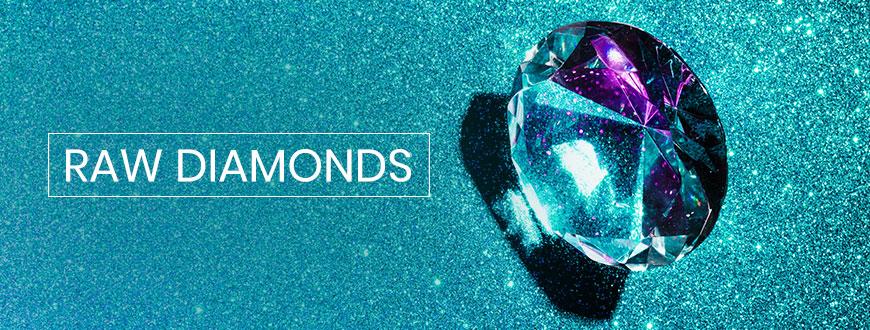Kalyan Wiki

Raw diamonds
Raw diamonds (also called rough diamonds) refer to uncut, unpolished diamonds that are sourced directly from nature. These diamonds may vary in colour, weight, shape and clarity. Traditionally, when a gem-quality diamond is processed from nature, it undergoes procedures to be cut and shaped to be added to jewellery.
The worth of a diamond is decided by these factors, as it is the cutting process, followed by polishing, that determines the way a diamond reflects light. However, when it comes to uncut diamonds, none of these processes is followed. Uncut diamonds instead retain their natural rawness and are unique gemstones that have an edge to them. Let us take a quick look at their attributes.
Quality And Features
Rough diamonds are extracted from mines in their natural state, and hence usually lack colour, lustre, and sparkle compared to polished diamonds. Rough diamonds are less glittery than refined diamonds because as we know, it is the cutting process that gives shape and clarity to diamonds. Although both cut and uncut diamonds share many similarities, the light reflecting the quality of a rough diamond will undoubtedly be inferior to that of a polished diamond. Uncut diamonds may resemble minerals such as quartz, as they have similar crystalline structures. However, many qualities make rough diamonds unique and identifiable from other minerals, like specific gravity and hardness. Diamonds being the hardest natural minerals rank ten on Moh’s Hardness Scale and have a specific gravity of 3.52.
Presence Of Impurities
Naturally occurring diamonds may have impurities or flaws in them, called inclusions. These inclusions may affect the amount of light reflected by them and their overall clarity and even colour. In the case of cut diamonds, these inclusions can be overlooked to the extent they can be fixed during the cutting process. However, uncut diamonds retain inclusions as they do not undergo the cutting process. Presence of impurities is a unique feature of rough diamonds. Many jewellers have started embracing their rough edge as a fashion statement.
Rough Diamonds And Kimberley Process
Rough diamonds are subject to an arduous process known as the Kimberly Process. Kimberley Process is a binding agreement that is in place to prevent the rough diamonds mined from conflict-affected zones from being sold in the international markets to fund wars or violence. Kimberley Process requires participants who trade rough diamonds to have KPCS, the Kimberly Process Certification Scheme. This certification safeguards the shipment of rough diamonds and certifies them as conflict-free. The World Diamond Council has created this system to ensure that the sale of diamonds is ethical.
Identifying A Rough Diamond
Identifying a rough diamond may be a daunting task for the untrained eye, as these diamonds lack the refinement gifted by the jeweller. Rough diamonds sometimes resemble other naturally occurring crystals. There is a common misconception that rough diamonds can be identified at home using methods like scratching glass with them. Although diamond is indeed a hard mineral that will create scratches on the glass, many other minerals are denser than glass and will create scratches on glass.
Glass stands at 5.5 on Moh’s Scale of hardness. Minerals such as Albite and Boracite rank higher than glass on the Moh’s Scale and can create scratches on glass, so tests like these could lead us to wrong results. One foolproof method to identify if a natural stone is a rough diamond is by scratching Corundum. Corundum ranks nine on the Moh’s Hardness Scale, and only diamonds can scratch them. Although these tests may give accurate results, it is always safe to leave the testing process to an expert.
Price
Compared to cut and polished diamonds, the price of raw diamonds is relatively lower per carat. This is because cutting a diamond is an expensive process as this process alone determines the brilliance with which a diamond shines. Depending on its proportions, a cut diamond will have its impurities removed, effectively reflect light, and shine better than a raw diamond. Polishing is another process that adds sparkle to the diamond. Avoiding these processes will bring down the cost of rough diamonds to some extent, but they may not still be cheaper. Depending on the lustre, carat and clarity, raw diamonds may be charged less than their cut and polished counterparts.
Rough Diamonds In Jewelry
Rough diamonds, with their inherent flaws, in their natural form are perhaps the best natural stones to symbolise the bond of marriage! For their charm, rough diamonds have opened up an exotic trend in wedding rings. They are also gaining approval among women all over the globe in other forms of jewellery, like neckpieces and earrings.







